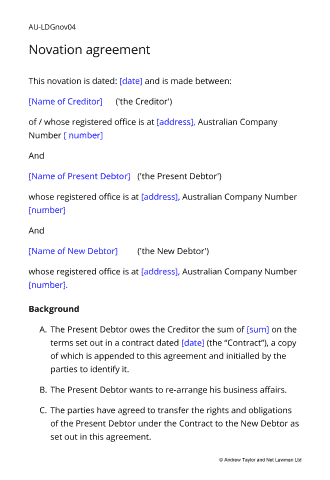Novation agreement

Document overview

 ACT
ACT NSW
NSW NT
NT QLD
QLD SA
SA TAS
TAS VIC
VIC WA
WA

- Length:5 pages (1590 words)
- Available in:
 Microsoft Word DOCX
Microsoft Word DOCX Apple Pages
Apple Pages RTF
RTF

If the document isn’t right for your circumstances for any reason, just tell us and we’ll refund you in full immediately.

We avoid legal terminology unless necessary. Plain English makes our documents easy to understand, easy to edit and more likely to be accepted.

You don’t need legal knowledge to use our documents. We explain what to edit and how in the guidance notes included at the end of the document.

Email us with questions about editing your document. Use our Lawyer Assist service if you’d like our legal team to check your document will do as you intend.

Our documents comply with the latest relevant law. Our lawyers regularly review how new law affects each document in our library.
About this novation agreement
Use this novation agreement to transfer a debt obligation from one party to another (i.e. change who will repay the debt). Common uses are when a business is sold and the purchaser takes on the liabilities of the seller, or when restructuring debt (a third party buys the obligation to repay a loan and interest).
A common misconception is that a novation of a debt is a cancellation of old debt in exchange for issuance of new. Instead, novation just changes the parties to the original contract and doesn’t create a new contract. In most cases, novation is an easier option than cancelling and drawing new agreements.
This is a simple yet comprehensive agreement that can be used to novate any debt, usually with only minimal editing.
The consent of all three parties - the transferee, the transferor and the other contracting party - is required to effect any novation. Unless you specifically require the consent of the other contracting party (perhaps because your contract has a non-assignment clause), our assignment agreement may be an even simpler way of transferring your contract to someone else.
Why not a deed of novation?
The deed format is used where one party to a contract receives no consideration. However, a novation is invariably "for value", and as such, a deed of novation confers little additional advantage.
In the unlikely event that a party agrees to novation out of pure kindness, the consideration can be entered as “one pound”, or a "peppercorn". The sum does not need to have any relation to the value of the debt being novated.
When to use this novation agreement
This document can be used to transfer any loan or debt to an individual or company provided that the creditor agrees to the transfer.
You should use this novation agreement, rather than an assignment agreement if all parties to the contract will agree to the change and sign the contract. Its usually easier just to get the transferring parties to sign an assignment agreement, but some contracts have non-assignment clauses that mean that novation is the only valid way of transferring the contract to someone else. If in doubt, use this agreement and obtain consent from all involved.
Changing who will receive the debt repayments
If you want to transfer the debt to another creditor (i.e. change who will receive the repayments), then the following novation agreement will be more suitable: Novation agreement: transfer debt to new creditor
Agreement features and contents
- Suitable when either party is resident outside the Australia;
- Ensures a legal transfer as it is drawn as an agreement between all parties;
- Comprehensive provisions provide ideas for you to mould
The agreement contains the following sections:
- Details of the parties;
- Indemintity to protect both parties from loss, damage or legal liability once the contract is transferred;
- The novation;
- Existing claims: sets out how outstanding claims against the transferor will be dealt with;
- Costs: identifies who will bear costs incurred to date;
- Other usual legal provisions in plain English.

Recent reviews
I can tell however that the service is excellent. The document is not merely a template; it is a form, where the parts that need modifications are highlighted, along with notes to indicate which and why, and also what part should not be modified and why. There are also examples of typical additions, such as claim, etc. Finally, the document comes with a general "Guide to edit Legal Documents".
Choose the level of support you need
Document Only
This document
Detailed guidance notes explaining how to edit each paragraph
Lawyer Assist
This document
Detailed guidance notes explaining how to edit each paragraph
Unlimited email support - ask our legal team any question related to completing the document
- Review of your edited document by our legal team including:
- reporting on whether your changes comply with the law
- answering your questions about how to word a new clause or achieve an outcome
- checking that your use of defined terms is correct and consistent
- correcting spelling mistakes
- reformatting the document ready to sign
All rights reserved
